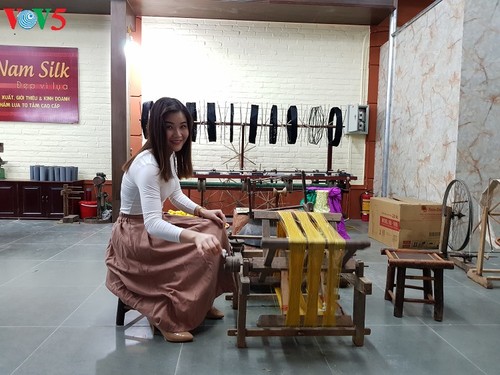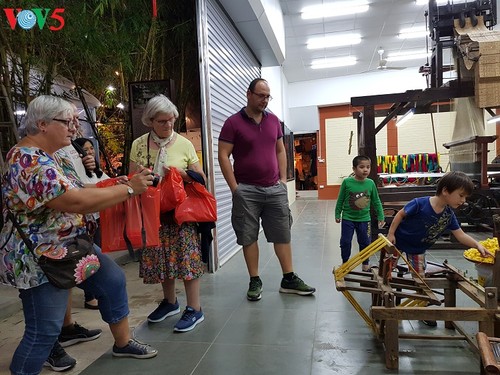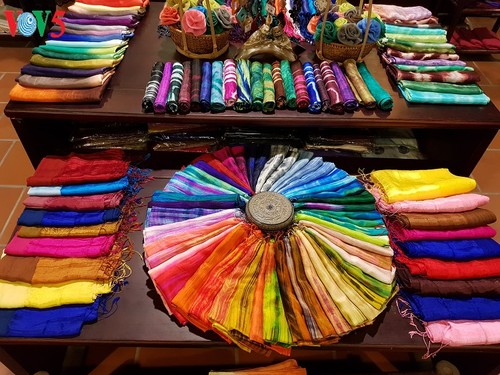
Visitors take photos and participate in silk weaving demonstration at the festival.
|
Located 10 km west of downtown Hanoi, Van Phuc silk village has provided a wealth of inspiration for poetry, songs, and paintings.
Van Phuc silk is soft, smooth, and glossy and features simple, symmetrical patterns. The event had 120 stalls, 20 of which represent craft villages in Hanoi and a handful of northern provinces.
Pham Khac Ha, Chairman of Van Phuc Silk Weaving Village Association, said: “We have staged an art performance for each day of the week, introducing and promoting Van Phuc silk products. An open space has been organized, where visitors will be able to tour the President Ho Chi Minh Commemorative House, Van Phuc Shrine, Van Phuc Temple, Van Phuc Pagoda, and the Temple to worship the forefathers of the craft. We have set up an area to demonstrate silk weaving and its production process while the village’s signature products are displayed at the Center for Van Phuc Silk Preservation. We have arranged silk making, cuisine, flower, and silk trade streets.”

Foreign visitors at the festival
|
Nearly 1,000 people participated in a procession at the opening ceremony entitled “Van Phuc of old days” to honor the craft’s forefathers and its historical and cultural values.
Nguyen Van Nam, the owner of Nguyet Nam silk weaving workshop in Van Phuc, said: “Van Phuc ward offer visitors hands-on experience weaving silk. The silk production process includes silk worm breeding, silk bleaching, dying, reeling, and the bobbin to put into the loom. Though the current loom has been improved, basically the production process is still conducted manually. As a result, up to 4 meters of fabric is woven daily.”
Other activities at the week-long festival included a water puppet show, Quan Ho singing, call-and-response singing, and Chau Van, a Vietnamese form of ritual singing.
Art competitions involving 12 teams of Van Phuc locals, folk games, and a fashion show featuring Ao Dai (the traditional Vietnamese long dress) entertained tourists while stores sold silk products every day of the event. Local dishes were served at the food stalls and bonsai plants and flowers were available onsite.

Van Phuc silk products.
|
Pham Do Thanh, a tourist from Hanoi, said: “I come to the festival to visit the village and to buy silk products. I have used Van Phuc silk for its rich patterns and quality, particularly the Van and Gam (embroidered) varieties silk. What impresses me most is the walking street and the cuisine street. There are walking streets in Hanoi’s old quarters and in the West Lake. Now with the launch of the Van Phuc walking street we will have more places to go out on the weekend.”
Luu Duy Dan, Chairman of the Vietnamese Craft Village Association, said: “From the Van Phuc Culture, Tourism, and Trading Handicraft Village, it’s possible to set up a regular market-day at Van Phuc craft village. In addition to traditional products made by the craft village, cuisine, folk games, and exchanges with local artisans are offered to visitors.”
The festival aims to promote Van Phuc’s silk weaving craft and Hanoi’s trade and tourism, especially craft village tourism.